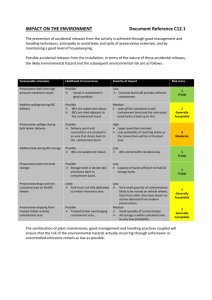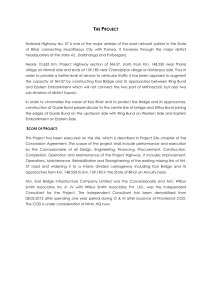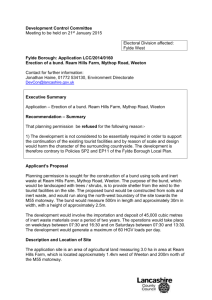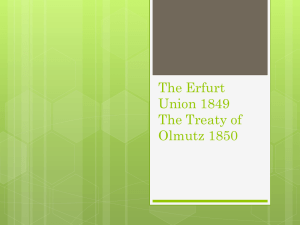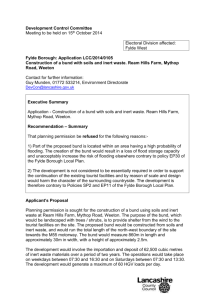Get the entire paper
advertisement
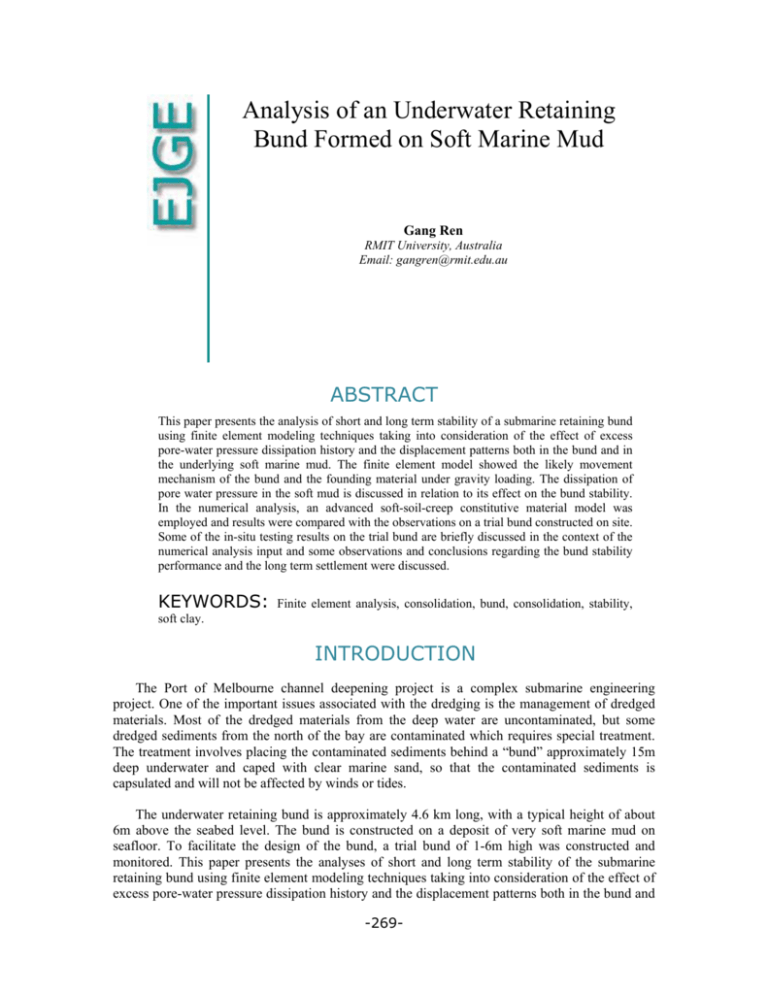
Analysis of an Underwater Retaining Bund Formed on Soft Marine Mud Gang Ren RMIT University, Australia Email: gangren@rmit.edu.au ABSTRACT This paper presents the analysis of short and long term stability of a submarine retaining bund using finite element modeling techniques taking into consideration of the effect of excess pore-water pressure dissipation history and the displacement patterns both in the bund and in the underlying soft marine mud. The finite element model showed the likely movement mechanism of the bund and the founding material under gravity loading. The dissipation of pore water pressure in the soft mud is discussed in relation to its effect on the bund stability. In the numerical analysis, an advanced soft-soil-creep constitutive material model was employed and results were compared with the observations on a trial bund constructed on site. Some of the in-situ testing results on the trial bund are briefly discussed in the context of the numerical analysis input and some observations and conclusions regarding the bund stability performance and the long term settlement were discussed. KEYWORDS: Finite element analysis, consolidation, bund, consolidation, stability, soft clay. INTRODUCTION The Port of Melbourne channel deepening project is a complex submarine engineering project. One of the important issues associated with the dredging is the management of dredged materials. Most of the dredged materials from the deep water are uncontaminated, but some dredged sediments from the north of the bay are contaminated which requires special treatment. The treatment involves placing the contaminated sediments behind a “bund” approximately 15m deep underwater and caped with clear marine sand, so that the contaminated sediments is capsulated and will not be affected by winds or tides. The underwater retaining bund is approximately 4.6 km long, with a typical height of about 6m above the seabed level. The bund is constructed on a deposit of very soft marine mud on seafloor. To facilitate the design of the bund, a trial bund of 1-6m high was constructed and monitored. This paper presents the analyses of short and long term stability of the submarine retaining bund using finite element modeling techniques taking into consideration of the effect of excess pore-water pressure dissipation history and the displacement patterns both in the bund and -269- Vol. 15 [2010], Bund. C 270 in the underlying soft marine mud. The finite element model is analyzed to show the possible movement mechanism of the bund and the founding material under gravity loading. The dissipation of pore water pressure in the soft mud is also discussed in relation to its effect on the bund stability. Some of the in-situ testing results on the trial bund are briefly discussed in the context of the numerical analysis input and some interesting observations and conclusions regarding the bund stability performance and the long term settlement were presented in the paper. The design and management of the bund requires knowledge and understanding of the mechanical behavior of the bund and the underlying supporting soft marine mud. The main concerns in the design of the submarine bund are the low bearing capacity of the soft marine mud at the seabed and the long-term consolidation settlement of the bund. Ground investigations revealed that the seabed at the bund area comprises approximately 5m thick very soft marine deposits referred to as the Central Bay Mud (CBM), which is overlying stiff clay material- the Fishermen’s Bend Silt (FBS). Cone Penetration Tests (CPT) carried out in the offshore geotechnical investigation suggested that the CBM could have possessed undrained shear strength as low as 1.5kPa at shallow depth. It is also revealed that occasionally there are deeper deposits of the CBM, associated with Late Pleistocene channels eroded into the surface of the underlying stiff clay. The finite element computer program PLAXIS was used for the analysis of the bund. PLAXIS is a commercially available finite element package specifically designed for twodimensional geotechnical analysis. PLAXIS makes use of advanced constitutive models for the simulation of non-linear behavior of soils. NUMERICAL ANALYSIS Finite Element Model and Geotechnical Parameters The geotechnical model was set up based on the geotechnical information revealed in the site investigations and local experience (Peck et al. 1992). The PLAXIS model was initially developed using a simple geometry with a single set of soil parameters for each of layer of bund soil. Complexity was gradually built up to cater for the variations in material strength and permeability in the bund. The final model for the bund was divided in 6 layers with differentiated material properties. The construction process was simulated by staged construction sequence in the PLAXIS analysis. The following construction sequence was adopted in the modeling: 1. 2. 3. 4. 5. 6. 7. Generate initial field stresses and pore water pressure under the gravity loading. Construct the bund layer by layer (total 6 layers) and generate excess pore water pressure; Allow consolidation to take place for a given period of time; Place the New Dredged Material (NDM) behind the bund; Allow a period of time for consolidation; Perform analysis to reach 90% of total consolidation; Perform analysis to full consolidation. Vol. 15 [2010], Bund. C 271 The bund materials dredged from the channel mainly comprise of the Fishermen’s Bend Silt (FBS) and calcareous siltstone/sandstones. The physical properties of dredged materials are governed by the source materials and the way the bund is constructed. A series of studies have been undertaken into the engineering properties of the bund materials based on the CPT testing during the off-shore site investigation and laboratory soil index testing. The following geotechnical parameters were adopted in the analysis: Table 1: Bund Material Parameter Values γbulk ky kx E c' φ' kN/m3 m/s m/s kPa kPa º 18.1 1.9×106 9.7×106 800 0 40 0.3 10 2 18.7 4.6×107 2.3×106 800 0 40 0.3 10 3 18.9 1.0×107 5.1×107 800 0 40 0.3 10 4 19.0 2.2×108 1.1×107 800 0 40 0.3 10 5 19.2 4.6×109 2.3×108 800 0 40 0.3 10 6 19.3 9.4×109 4.7×109 800 0 40 0.3 10 Layer 1 ν ψ º where γbulk = Bulk unit weight; kx = coefficient of horizontal permeability; ky = coefficient of vertical permeability; E= Young’s modulus; c'= cohesion (in terms of effective stress); φ' = Effective internal friction angle; ν = Poisson’s ratio; ψ = Dilatancy angle. As the bund is to be constructed in layers, the coefficient of permeability along the horizontal direction is expected to differ from that of the vertical. Table 2: CBM Soil Parameter Values γbulk Layer 1 ky 3 kN/m m/s 10.0 1.3×109 kx E m/s kPa 6.7×109 600 c' φ' ν ψ kPa 0.5 º 15 0.3 º 5 Table 3: NDM Soil Parameter Values γbulk Layer 1 ky 3 kN/m 12.2 kx m/s m/s 1.0×108 1.0×108 E c' φ' ν ψ kPa 800 kPa 0.5 º 40 0.3 º 10 Table 4: FBS Soil Parameter Values γbulk Layer 1 ky 3 kN/m 18.6 kx m/s m/s 1.0×109 3.0×109 E c' φ' ν ψ kPa 7800 kPa 0.5 º 29 0.3 º 10 Vol. 15 [2010], Bund. C 272 Constitutive Model The materials encountered in the bund area during the site investigations are variable, both laterally and vertically, in terms of stiffness, permeability and strength. PLAXIS incorporates a number of constitutive models for studying soil behaviour, including Mohr-Coulomb (M-C), softsoil-creep (SSC) Models. In this study, the conventional M-C model was initially attempted but proven to have limited success. The SSC model was subsequently adopted for analysis, as it is a non-linear elasto-plastic model that can incorporate secondary compression and changes in stiffness and permeability. The model can be used to simulate the time-dependent behavior of soft soils. It is considered that the SSC model is more appropriate for simulating the behavior of CBM under the gravity load of the bund. The required input parameters for SSC model and their relationship to the internationally normalized parameters (Plaxis Material Models Manual 2002): λ* = Cc 2.3(1 + e) (1) 2 Cr 2.3 (1 + e) (2) λ* is the modified compression index Cc is the one-dimensional consolidation compression index e is the void ratio κ*= κ * is the modified swelling index Cr is the one-dimensional consolidation swelling index u*= Cα 2.3(1+ e) (3) u * is the modified creep index Cα is the one-dimensional consolidation creep index The Cc, Cr and Ca parameters can be established from one-dimensional consolidation test. The SSC model allows the input of the secondary compression which is considered appropriate for the CBM. The following parameters in Table 5 for the CBM were used in the SSC model. Table 5: Input parameters for CBM Soft-soil-creep Model Type γunsat[kN/m³] γsat[kN/m³] λ κ* u* CBM SSC 10.00 13.00 0.1 0.002 0.009 Vol. 15 [2010], Bund. C 273 Figure 1: Finite Element Model for the Retaining Bund Description of General Model Behavior The bund is essentially gravity loaded material and it will consolidate under its own weight. The bund also applies gravity load on the CBM on the seafloor. The movements take place in soft CBM layer as soon as the first layer of bund material is placed. Figures 2 to 5 show the movement patterns of the bund during initial construction and subsequent consolidation. Max. displacement 50mm Figure 2a: Immediate Movement Patterns before consolidation. Figure 2b: Close-up view of Immediate Movement Patterns in CBM From Figure 2b it can be seen that the material displacement in the CBM is predominantly horizontal, indicating that the soft mud is displaced sideways during the gravity loading of the bund. The model predicted a maximum settlement of approximately 50mm immediate settlement. The settlement mechanism involves the initial settlement of the bund and the depression in the Vol. 15 [2010], Bund. C 274 CBM and subsequently time related consolidation settlement taking place both in the bund and the CBM. From this model, it can be seen that the initial maximum settlement is in the order 50mm and will further settle to 85mm in 60 days. Settlement of bund continues after the placement of NDM due to combined effects of the placement of NDM and the further consolidation of the bund material. At 120 days after placing the NDM behind the bund, the maximum settlement will reach 130mm (Figure 4). A final settlement of 440mm is calculated in this particular model (Figure 5). Figures 2 to 6 show that the initial loading of the bund causes a “squeeze” effect on the underlying CBM, which demonstrated a predominately horizontal movement pattern. In the subsequent consolidation, the movement pattern turns “vertical”. This analysis in movement patterns is considered reasonable and is consistent with the observation in the trial bund construction. It should be noted that the magnitude of settlement calculated in the model is mainly dependant of the Young’s moduli adopted for the model materials. The observed settlement may be well in excess of the calculated values. The Young’s modulus value of CBM may be interpreted from the Cone Penetration Tests (CPT) carried out in the off-shore investigation. The CPT results (Figure 6) indicated that the strength and stiffness of the bund and CBM materials vary with depth. The cone resistances in the CBM are generally very low. The Young’s modulus parameters adopted in Tables 1 and 2 were based on a broad correlation with the material description encountered in the ground investigation and the results obtained from laboratory testing as well as the CPT results. Max. displacement 85mm Figure 3: Movement Patterns after 60 days consolidation. New Dredged Material (NDM) Max. displacement 130mm Figure 4: Movement Patterns Movement Patterns 120 days after placement of NDM Vol. 15 [2010], Bund. C 275 Max. displacement 440mm Figure 5: Movement Patterns after Completion of Consolidation Figure 6: CPT Cone resistance Test Results The numerical analysis showed that the bund model was generally stable during the construction phases. This is principally due to the low sloping angle of the bund. Vol. 15 [2010], Bund. C 276 Development of Pore Water Pressures The bund will be constructed in relatively short period of time. In the numerical modeling, the time allowed for consolidation in construction stage was 60 days. The consolidation in the CBM would take place as soon as gravity loading is applied by the placement of bund material. One of key interests in the finite element analysis is the development of the excess pore water pressure in the CBM and the bund itself during the construction of the bund and placement of NDM behind the bund. The materials have been assumed to be “undrained type” to allow the built-up of excess pore water pressure within the bund and the underlying CBM. The generation and dissipation of the excess pore water pressure during the initial and final stage of consolidation are illustrated in Figures 7a to 7h. It is interesting to note that at the initial stage, the excess pore water pressure is developed rapidly upon gravity loading of the bund material. The excess pore water pressure is also generated in the bund itself. The construction of bund was simulated by adding layer by layer (Layer 1 to Layer 6), which allows the accumulation of excess pore water pressure in the bund. It can be seen that the maximum excess pore water pressure is between 30 to 32 kPa (Figure 7a). After 60 days, the excess pore water pressure in the FBS dissipated significantly, whereas the excess pore water pressure in the CBM reduced a little. Some reduction of the excess pore water pressure in the bund is evident (Figure 7b). When the NDM was placed behind the Bund, the excess pore water pressure was developed under the NDM mainly within the CBM and the FBS layers. The pattern of the water pressure shows unsymmetrical distribution due to the NDM placement at one side of the Bund (Figure 7c). Figure 7d shows the distribution of excess pore water 60 days after the placement of the NDM, where the excess pore water pressure gradually dissipated in the NDM and the FBS layers. Noticeable excess pore water still trapped in the CBM due to its lower permeability. The excess pore water gradually dissipated with time as shown in Figures 7e and 7f, until reached 90% consolidation (Figure 7g) after a total period of approximately 2.5 years. The model predicted that consolidation in the CBM would take approximately 5 years to complete. Vol. 15 [2010], Bund. C Figure 7a: Excess Pore Water Pressure right after Construction of Bund - Stage 1: Construction of Bund Figure 7b: Excess Pore Water Pressure 60 days after Construction of Bund - Stage 2: Allow 60 days for consolidation Figure 7c: Excess Pore Water Pressure after Placement of NDM - Stage 3: Placement of NDM Figure 7d: Excess Pore Water Pressure 60 days after Placement of NDM - Stage 4: Allow 60 days for consolidation after NDM Figure 7e: Excess Pore Water Pressure 180 days after Placement of NDM - Stage 5: At 180 days after placement of NDM Figure 7f: Excess Pore Water Pressure 365 days after Placement of NDM - Stage 6: At 365 days after placement of NDM 277 Vol. 15 [2010], Bund. C 278 Figure 7g: Excess Pore Water Pressure at 90% consolidation Figure 7h: Excess Pore Water Pressure at 100% consolidation Figure 8a shows the history of pore water pressure with time at three reference points A, B and C (see Figure 1). Figure 8b is the “zoomed” version of Figure 8a showing detail of the excess pore water pressure change during the initial 120 days. Note that point “A” is in the CBM and point “B” is in the mid-bund close to the CBM, whereas point “C” is in shoulder of the bund close to the NDM. . Figure 8a: Excess Pore Water Pressure change with Time from initial loading to completion of consolidation Vol. 15 [2010], Bund. C 279 Figure 8b: Excess Pore Water Pressure change with Time During the first 120 days As shown in Figure 8b, the excess pore water pressure in the CBM layer at Point A was built up almost instantly upon the imposed Bund gravity load. This pore water pressure started to dissipate very slowing in the first 120 days. At Point B in the bund, the excess pore water pressure relieved relatively fast in the first 60 days. The rate of dissipation became slower after the initial 60 days. At Point C the pore water pressure was affected by the placement of the NDM behind the Bund (see Figure 8b) and the initial dissipation rate was slow. The consolidation in the bund was complete well ahead of the CBM. Model Verification The initial excess pore water pressure in CBM generated by the gravity loading of the bund can be estimated by: du = H (γsat – γwater) where du is the excess pore water pressure due to bund gravity loading. H is the height of the bund (6m) γsat is the saturated unit weight of bund material γwater is the unit weight of water As the bund is under water, we have du = 6(15.2-10) = 31.2kPa. This value is almost identical to the Finite Element analytical result where the maximum excess pore water pressure in the model is 30-32 kPa as illustrated in Figures 7a, 8a and 8b. Vol. 15 [2010], Bund. C 280 DISCUSSION The finite element bund model demonstrated the feasibility of constructing an underwater bund on a very soft Central Bay Mud (CBM) deposit. A long term consolidation settlement would be expected long after the bund construction. The magnitude of the consolidation settlement could be as much as over 5 times of the initial elastic settlement (Figures 3 and 5). Despite of the low shear strength of the Central Bay Bud (CBM), the retaining bund can be safety built over the CBM as long as the bund slope is kept at a low angle. The finite element model has also showed the initial “punching in” effect of the bund material on the CBM, which effectively helped the bund to “key in” with the CBM. The low bund sloping angle would ensure the stability of the bund even the CBM has a very low shear strength. It has been long recognized that the short-term stability of an embankment built on soft clay would be related to the development of excess pore water pressure in the soft clay. The critical stage in terms of stability would be in the construction period during which there is very little dissipation of pore water pressure. Depend on the permeability of the soft clay; the consolidation process would take considerable time to complete. The stability of the bund is expected to improve as consolidation is taking place. However, as time taken to complete the consolidation process is very long in this case, there is very little merit to delay the placement of the bund material for the benefit of gaining in shear strength of the CBM. Therefore it is not recommended to construction the bund in stages for the purpose of improving stability. Furthermore, the numerical model provided some insights into a history of the development of the excess pore water pressure in all soil layers, in particular the CBM layer. REFERENCES 1. Adachi, T., Oka, F. (1982) Constitutive equation for normally consoildated clays base on elasto-viscoplasticity. Soil and Foundations 22: 57-70 2. Borja, R. I., Kavaznjian, E. (1985) A constitutive model for the g-e-t behaviour of wet clay. Geotechnique 35:283-298. 3. Peck WA et al. (1992) Engineering Geology of Melbourne: Proceedings of the Seminar on Engineering Geology of Melbourne, Victoria, Australia. 4. Sinclair Knight Merz —SKM (2005) Final Bund Design Report, Channel Deepening Project – EES, Port of Melbourne – Dredged Material Grounds, for Port of Melbourne Cooperation. 5. Sinclair Knight Merz—SKM (2004) Report on Stage 2 Additional Environmental survey Work, channel Deepening Project – EES, Special Studies for Port of Melbourne Cooperation. 6. Delft University of Technology & Plaxis b.v. (2002) Plaxis User’s Manual Version 8. © 2010 ejge
